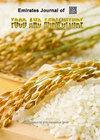利用胚乳培养硬质小麦与玉米杂交产生的单倍体胚胎
IF 0.7
4区 农林科学
Q3 AGRONOMY
引用次数: 0
摘要
在植物育种计划中使用加倍单倍体可加快推出适应气候变化的新品种。硬质小麦 x 玉米杂交技术是生产硬质小麦单倍体植株的首选方法。用这种方法产生的单倍体胚胎在发育过程中没有蛋白,授粉后的激素处理确保了胚胎的存活。在这项研究中,对 7 种硬质小麦基因型进行了 9 次授粉后处理,分别使用浓度为 10、50 和 100 mg.L-1 的 2,4-二氯苯氧乙酸(2,4-D)、吡克草胺(Picloram)和麦草畏(Dicamba)。研究了基因型和授粉后处理对硬质小麦 x 玉米杂交产生的硬质小麦单倍体胚的影响,以及使用胚乳抚育技术进行单倍体植株再生的情况。单倍体诱导参数随硬质小麦基因型和授粉后处理方法的不同而变化。本文首次报道了硬粒小麦与玉米杂交产生的多胚现象。硬粒小麦基因型产生单胚和多胚的能力各不相同。授粉后使用 2,4-D(10 mg.L-1)和毒死蜱(10 和 100 mg.L-1)处理比使用麦草畏处理的胚形成率更高。使用硬质小麦胚乳作为补充营养物,并结合 Gamborg B5 再生培养基,胚转化为小植株的能力大大提高,尤其是对顽抗基因型。 关键词硬质小麦 单倍体胚胎 玉米 胚乳营养技术 多胚性本文章由计算机程序翻译,如有差异,请以英文原文为准。
Use of nurse endosperm for the culture of haploid embryos produced by durum wheat x maize crosses
The use of doubled-haploids in plant breeding programs enables accelerating the release of new varieties adapted to climate change. The durum wheat x maize crosses technique is a method of choice for producing durum wheat haploid plants. The haploid embryos produced by this method develop without albumen and their survival is ensured by post-pollination hormonal treatments. In this study, nine post-pollination treatments with 2,4-Dichlorophenoxyacetic acid (2,4-D), Picloram and Dicamba at the concentrations of 10, 50 and 100 mg.L-1 were applied to 7 durum wheat genotypes. The effects of genotype and post-pollination treatment on durum wheat haploid embryos produced by durum wheat x maize crosses and the use of the endosperm nursing technique for haploid plantlets regeneration were investigated. The haploid induction parameters varied with the durum wheat genotypes as well as the post-pollination treatments. The phenomenon of polyembryony resulting from durum wheat x maize crosses is reported for the first time in this article. The durum wheat genotypes showed different abilities to produce monoembryo and polyembryos. The post-pollination treatments with 2,4-D (10 mg.L-1) and Picloram (10 and 100 mg.L-1) gave a higher embryo formation frequency than the treatments with Dicamba. The embryo conversion to plantlet was greatly improved, especially in recalcitrant genotypes using the durum wheat endosperm as supplemental nourishment in combination with the Gamborg B5 regeneration medium. Keywords: Durum wheat; Haploid embryo; Maize; Nurse Endosperm Technique; Polyembryony
求助全文
通过发布文献求助,成功后即可免费获取论文全文。
去求助
来源期刊

Emirates Journal of Food and Agriculture
AGRONOMYFOOD SCIENCE & TECHNOLOGY&nb-FOOD SCIENCE & TECHNOLOGY
CiteScore
1.80
自引率
0.00%
发文量
18
期刊介绍:
The "Emirates Journal of Food and Agriculture [EJFA]" is a unique, peer-reviewed Journal of Food and Agriculture publishing basic and applied research articles in the field of agricultural and food sciences by the College of Food and Agriculture, United Arab Emirates University, United Arab Emirates.
 求助内容:
求助内容: 应助结果提醒方式:
应助结果提醒方式:


